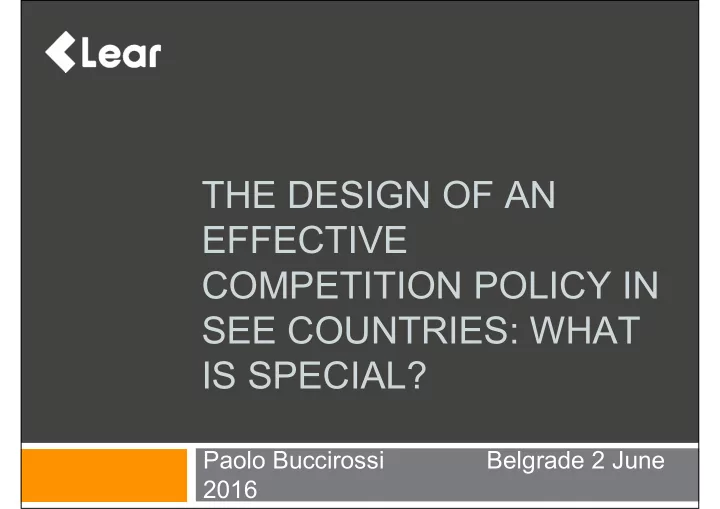

THE DESIGN OF AN EFFECTIVE COMPETITION POLICY IN SEE COUNTRIES: WHAT IS SPECIAL? Paolo Buccirossi Belgrade 2 June 2016
Outline The issue: Does the design of an effective competition policy regime depend on the characteristics of a country? How? Relevant country specific characteristics Relevant features of the competition policy regime Where SEE countries stand Tentative conclusions
The issue Does the design of an effective competition policy regime depend on the characteristics of a country? How?
Benefits of legal transplant Savings on rule design Reliance on an extensive case law for rules’ interpretation Reduce trade barriers International coordination in competition law enforcement International pressure helps resist vested interests
Costs of legal transplant External pressure: psychological effects – lack of political support Inadequate human and financial resources to apply sophisticated analyses: wrong and harmful decisions Inability to tackle the main actual obstacles to competition Inappropriate goals
Relevant characteristics
Overview Economic characteristics Institutional characteristics Political characteristics Social and cultural characteristics
Economic characteristics Level of economic development (income) Barriers resulting from inadequate infrastructures Economic vulnerability and inequality of income distribution Role of the State in the provision of goods and services
Institutional characteristics Development of financial institutions Effectiveness and efficiency of the court system Protection of property rights Rule of law Red tape
Political and Social & Cultural characteristics Political stability Corruption Existence of a competitive culture
Features of the competition regime
Overview Administrative model vs judicial model Independence of the competition authority Complexity of analysis: e.g. per se rule vs. rule of reason, the role of presumptions Level of discretion and transparency Scope of application (e.g. merger control regime) Investigative powers Sanction policy (type of sanction – e.g. criminal vs administrative – level of fines, adoption of leniency programs and settlement schemes) Setting priorities and goals Exemptions Advocacy vs enforcement
No compromise Independence of the competition authority Transparency Investigative powers Goals: efficiency
Adapting Complexity of analysis Simple “per se” rule may perform better, at least in an initial stage Rely on presumptions also for exemptions Limit discretion Sanction policy Administrative sanctions Lower fines Leniency programs and settlement schemes Setting priorities Advocacy may play a more important role Scope of application: depending on the available resources
Overview Administrative model vs judicial model Independence of the competition authority Complexity of analysis: e.g. per se rule vs. rule of reason, the role of presumptions Level of discretion and transparency Scope of application (e.g. merger control regime) Investigative powers Sanction policy (type of sanction – e.g. criminal vs administrative – level of fines, adoption of leniency programs and settlement schemes) Setting priorities and goals Exemptions Advocacy vs enforcement
SEE countries
Income Source: World Bank
Relevance of economic sectors Source: World Bank
Infrastructures-1 Source: World Economic Forum
Infrastructures-2 Source: World Economic Forum
Income distribution inequality Source: World Bank
Institutions-1 Source: World Economic Forum
Institutions-2 Source: World Economic Forum
Institutions-3 Source: World Economic Forum
Institutions-4 Source: World Bank
Political factors-1 Source: World Bank
Political factors-2 Source: World Economic Forum
Conclusions…
…to be checked The EU competition policy regime looks attractive Geographical proximity Political reasons Need to be adapted Simplify rules: use of presumptions Relevance of advocacy initiatives No compromise on fundamental features Building capacity to move to a more nuanced competition policy regime
Recommend
More recommend